If Estonia is closer to Finland and Lithuania is closer to Poland, Latvia must be closer to the rest of the world. Latvia, with its world-class capital of Riga and three major ports, is ideally suited to become a regional and international center for trade, commerce, finance and tourism. This has always been Latvia’s historical role and it is one we must continue to develop in the 21st century.”
– Ojārs Kalniņš, Director of the Latvian Institute
Buenos Aires – This weekend was the Mārtiņi Festival in Latvia – a traditional festival that celebrates the move from the fall to winter god (Martins), the end of all that pesky salting and preserving of food, and the advent of fun activities like skiing, sledding, masquerades, hanging crosses on the door, and rooster killing. It has nothing to do with the Martini cocktail. It also had only tangential relation to our Casa S dinner… no, that’s not true – I used the flavors and combinations of traditional dishes as inspiration for some of my own.
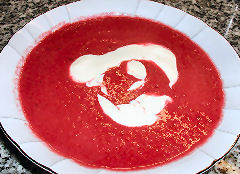 There are lots of winter-ish vegetable combinations that sounded interesting – things with beets, carrots, potatoes, white beans – and initially I was thinking about making a vegetable terrine combining all of the above. But I’m constantly being asked for soups by regular attendees at the dinners – soup is, amazingly, a hard thing to find here in Buenos Aires. Really. Look at almost any menu (other than maybe in a Chinese restaurant). A soup appetizer is a rarity. Not surprisingly, given its location, some version of borscht is a classic for the area. I decided to combine both beets and carrots in this brilliantly hued dish. It’s made with a base of chicken stock, beets, carrots, onions, garlic, ginger, orange and lemon peel, marjoram, salt, and white pepper. That’s it. Cooked the vegetables together until they were starting to soften, then simmered in the stock until they were done. Coarsely pureed. And, of course, topped with sour cream – which is non-existent here, so i made my own – it’s really pretty simple – take a container of heavy cream (about a cup and a half) and add the juice of one lemon. Stir, and let it sit for a little while – not long – it happens very quickly.
There are lots of winter-ish vegetable combinations that sounded interesting – things with beets, carrots, potatoes, white beans – and initially I was thinking about making a vegetable terrine combining all of the above. But I’m constantly being asked for soups by regular attendees at the dinners – soup is, amazingly, a hard thing to find here in Buenos Aires. Really. Look at almost any menu (other than maybe in a Chinese restaurant). A soup appetizer is a rarity. Not surprisingly, given its location, some version of borscht is a classic for the area. I decided to combine both beets and carrots in this brilliantly hued dish. It’s made with a base of chicken stock, beets, carrots, onions, garlic, ginger, orange and lemon peel, marjoram, salt, and white pepper. That’s it. Cooked the vegetables together until they were starting to soften, then simmered in the stock until they were done. Coarsely pureed. And, of course, topped with sour cream – which is non-existent here, so i made my own – it’s really pretty simple – take a container of heavy cream (about a cup and a half) and add the juice of one lemon. Stir, and let it sit for a little while – not long – it happens very quickly.
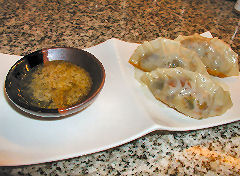 For course number two, I started with the idea of a traditional pirogi, which is, of course, an eastern European more or less equivalent to an empanada. I decided to combine a classic combination from some other Latvian dishes with bacon, shallots, potato, and wild mushrooms. Then I remembered my promise not to make another pork empanada until I’d made them with some other type of filling. So, I cheated. I made potstickers – which I like better anyway, as they’re lighter and more delicate. So, potstickers it was. I saw this note somewhere about a traditional dish for the season being cucumbers with honey, and somewhere along the line decided to place the potstickers on a bed of thinly sliced cucumbers, and give them a honey and mustard dipping sauce (mustard powder, salt, and honey dissolved in mirin).
For course number two, I started with the idea of a traditional pirogi, which is, of course, an eastern European more or less equivalent to an empanada. I decided to combine a classic combination from some other Latvian dishes with bacon, shallots, potato, and wild mushrooms. Then I remembered my promise not to make another pork empanada until I’d made them with some other type of filling. So, I cheated. I made potstickers – which I like better anyway, as they’re lighter and more delicate. So, potstickers it was. I saw this note somewhere about a traditional dish for the season being cucumbers with honey, and somewhere along the line decided to place the potstickers on a bed of thinly sliced cucumbers, and give them a honey and mustard dipping sauce (mustard powder, salt, and honey dissolved in mirin).
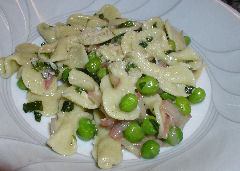 Apparently, there’s a traditional soup for this festival based on yellow peas and buttermilk (which doesn’t exist in Argentina and provided an interesting translation difficulty – jocoque is a thick style buttermilk in Mexico, suero de leche while technically correct, here usually just refers to the whey left over from cheesemaking). It sounded like something that you’d probably have to grow up on to really appreciate. Besides, I’d already planned the borscht for the first course. But, the idea of combining those flavors in a more subtle way struck me – I’ve been playing with different pastas recently, and it happens that I have some pea flour and some powdered buttermilk in the pantry – so, I simply made a basic pasta and added them to it – 1½ cups white flour, ¼ cup pea flour, 2 tablespoons powdered buttermilk, ¼ teaspoon salt, 2 extra large eggs, and 2 tablespoons of olive oil – just enough to give the pasta a subtle sour milk and pea flavor and turn it a light shade of green. I have a favorite recipe that I came up with years ago for a spring sort of pasta, and it’s spring here, even if not in Latvia – bowtie pasta with fresh peas, radishes, and mint, all cooked in butter. Really simple, and really quite good, and it seemed like a good match for the pasta. I decided to go with small bowtie pasta, tripolini, which are made from 1″ discs of pasta dough rather than fluted edge rectangles.
Apparently, there’s a traditional soup for this festival based on yellow peas and buttermilk (which doesn’t exist in Argentina and provided an interesting translation difficulty – jocoque is a thick style buttermilk in Mexico, suero de leche while technically correct, here usually just refers to the whey left over from cheesemaking). It sounded like something that you’d probably have to grow up on to really appreciate. Besides, I’d already planned the borscht for the first course. But, the idea of combining those flavors in a more subtle way struck me – I’ve been playing with different pastas recently, and it happens that I have some pea flour and some powdered buttermilk in the pantry – so, I simply made a basic pasta and added them to it – 1½ cups white flour, ¼ cup pea flour, 2 tablespoons powdered buttermilk, ¼ teaspoon salt, 2 extra large eggs, and 2 tablespoons of olive oil – just enough to give the pasta a subtle sour milk and pea flavor and turn it a light shade of green. I have a favorite recipe that I came up with years ago for a spring sort of pasta, and it’s spring here, even if not in Latvia – bowtie pasta with fresh peas, radishes, and mint, all cooked in butter. Really simple, and really quite good, and it seemed like a good match for the pasta. I decided to go with small bowtie pasta, tripolini, which are made from 1″ discs of pasta dough rather than fluted edge rectangles.
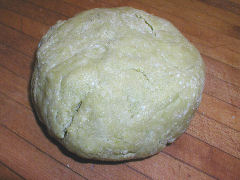
Mix the dough, knead it for a few minutes until smooth and then refrigerate for half an hour or more.
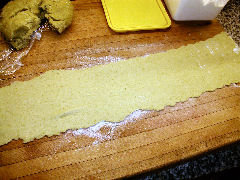
Roll a quarter of the dough out at a time to about 1/16″.
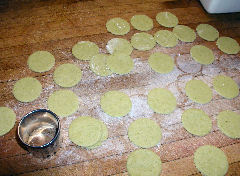
Cut 1″ circles of dough.
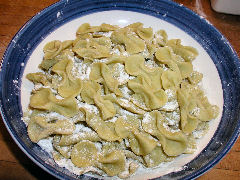
Pinch the circles into the center to create a mini-bowtie look – it helps to use a finger from the other hand to hold the center in place
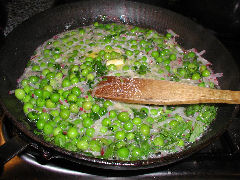
Blanch and shock the fresh peas, then cook in butter with finely julienned radishes, and chopped radish greens, mint, and basil. Season with salt and white pepper. Cook the pasta in boiling salted water. Mix together, and enjoy.
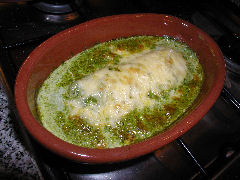 Apparently gratined fish is quite popular in the cuisine. Hake is, I gather, a favorite, here called merluza. Though slightly elaborate looking, this was pretty simple. The fish filets are cleaned and deboned and placed in a cazuela, or any similar ovenproof dish. I blanched and shocked some spinach and then pureed it into a mix of milk and cream (an idea I got from a recent lunch at José Luis), seasoned with salt and lots of paprika, and then poured it around the fish. Saute onions until just transluscent and limp, and place atop the fish, and then top the whole thing with some grated cheese – I used fynbo which has a rich, earthy note of buckwheat to it. Then stuck in the oven until cooked through and lightly browned on top.
Apparently gratined fish is quite popular in the cuisine. Hake is, I gather, a favorite, here called merluza. Though slightly elaborate looking, this was pretty simple. The fish filets are cleaned and deboned and placed in a cazuela, or any similar ovenproof dish. I blanched and shocked some spinach and then pureed it into a mix of milk and cream (an idea I got from a recent lunch at José Luis), seasoned with salt and lots of paprika, and then poured it around the fish. Saute onions until just transluscent and limp, and place atop the fish, and then top the whole thing with some grated cheese – I used fynbo which has a rich, earthy note of buckwheat to it. Then stuck in the oven until cooked through and lightly browned on top.
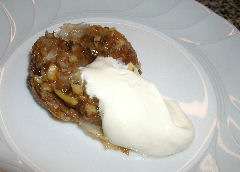 I love rhubarb. I grew up with rhubarb. The Latvians love rhubarb. I hear there’s some grown in Patagonia. I followed up on numerous leads – and visited more little markets than I care to count. The best I could determine was that occasionally, sometimes, now and then, a stalk or two of rhubarb arrives here in Buenos Aires and makes it to one or another of them. Maybe around this time of year, maybe not. I tried several Patagonian regional shops looking for a rhubarb preserve or something similar – something to get that tangy flavor. I finally found one jar, count it, one jar, at Diki, a little food shop in the 1100 block of Libertad, filled with oddities from all over the place (the shop, not the jar). The owner was surprised I even knew what rhubarb was, he said no one here does. And I have the last jar he had. I coated strudel pastry with butter, the rhubarb preserves, chopped walnuts, and brown sugar. Rolled it up, slathered it in more butter, and baked it until golden brown. Enough said…
I love rhubarb. I grew up with rhubarb. The Latvians love rhubarb. I hear there’s some grown in Patagonia. I followed up on numerous leads – and visited more little markets than I care to count. The best I could determine was that occasionally, sometimes, now and then, a stalk or two of rhubarb arrives here in Buenos Aires and makes it to one or another of them. Maybe around this time of year, maybe not. I tried several Patagonian regional shops looking for a rhubarb preserve or something similar – something to get that tangy flavor. I finally found one jar, count it, one jar, at Diki, a little food shop in the 1100 block of Libertad, filled with oddities from all over the place (the shop, not the jar). The owner was surprised I even knew what rhubarb was, he said no one here does. And I have the last jar he had. I coated strudel pastry with butter, the rhubarb preserves, chopped walnuts, and brown sugar. Rolled it up, slathered it in more butter, and baked it until golden brown. Enough said…
I’d leave you with a traditional Latvian toast, but I don’t know any…